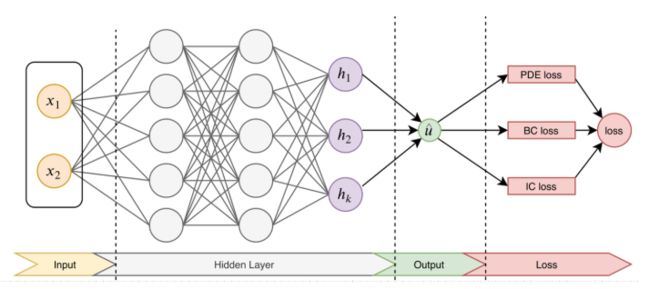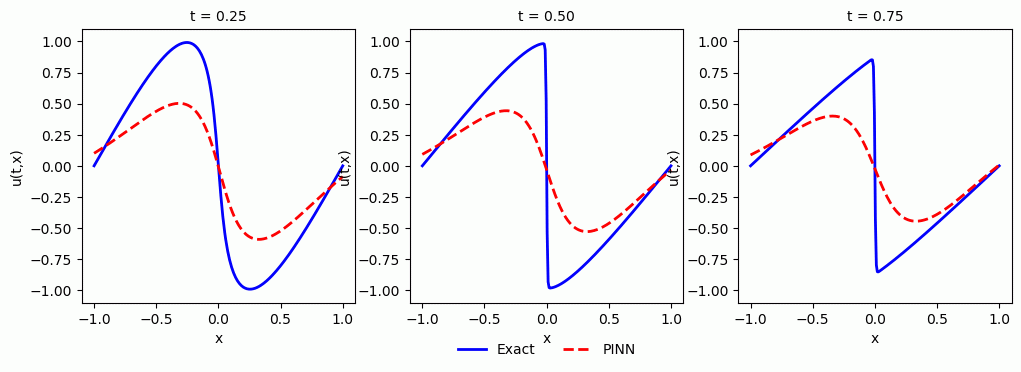深度学习求解微分方程系列四:基于自适应激活函数PINN求解burger方程逆问题
下面我将介绍内嵌物理知识神经网络(PINN)求解微分方程。首先介绍PINN基本方法,并基于Pytorch的PINN求解框架实现求解含时间项的一维burger方程。
内嵌物理知识神经网络(PINN)入门及相关论文
深度学习求解微分方程系列一:PINN求解框架(Poisson 1d)
深度学习求解微分方程系列二:PINN求解burger方程正问题
深度学习求解微分方程系列四:基于自适应激活函数PINN求解burger方程逆问题
1.PINN简介
神经网络作为一种强大的信息处理工具在计算机视觉、生物医学、 油气工程领域得到广泛应用, 引发多领域技术变革.。深度学习网络具有非常强的学习能力, 不仅能发现物理规律, 还能求解偏微分方程.。近年来,基于深度学习的偏微分方程求解已是研究新热点。内嵌物理知识神经网络(PINN)是一种科学机器在传统数值领域的应用方法,能够用于解决与偏微分方程 (PDE) 相关的各种问题,包括方程求解、参数反演、模型发现、控制与优化等。
2.PINN方法
PINN的主要思想如图1,先构建一个输出结果为 u ^ \hat{u} u^的神经网络,将其作为PDE解的代理模型,将PDE信息作为约束,编码到神经网络损失函数中进行训练。损失函数主要包括4部分:偏微分结构损失(PDE loss),边值条件损失(BC loss)、初值条件损失(IC loss)以及真实数据条件损失(Data loss)。

特别的,考虑下面这个的PDE问题,其中PDE的解 u ( x ) u(x) u(x)在 Ω ⊂ R d \Omega \subset \mathbb{R}^{d} Ω⊂Rd定义,其中 x = ( x 1 , … , x d ) \mathbf{x}=\left(x_{1}, \ldots, x_{d}\right) x=(x1,…,xd):
f ( x ; ∂ u ∂ x 1 , … , ∂ u ∂ x d ; ∂ 2 u ∂ x 1 ∂ x 1 , … , ∂ 2 u ∂ x 1 ∂ x d ) = 0 , x ∈ Ω f\left(\mathbf{x} ; \frac{\partial u}{\partial x_{1}}, \ldots, \frac{\partial u}{\partial x_{d}} ; \frac{\partial^{2} u}{\partial x_{1} \partial x_{1}}, \ldots, \frac{\partial^{2} u}{\partial x_{1} \partial x_{d}} \right)=0, \quad \mathbf{x} \in \Omega f(x;∂x1∂u,…,∂xd∂u;∂x1∂x1∂2u,…,∂x1∂xd∂2u)=0,x∈Ω
同时,满足下面的边界
B ( u , x ) = 0 on ∂ Ω \mathcal{B}(u, \mathbf{x})=0 \quad \text { on } \quad \partial \Omega B(u,x)=0 on ∂Ω
PINN求解过程主要包括:
- 第一步,首先定义D层全连接层的神经网络模型:
N Θ : = L D ∘ σ ∘ L D − 1 ∘ σ ∘ ⋯ ∘ σ ∘ L 1 N_{\Theta}:=L_D \circ \sigma \circ L_{D-1} \circ \sigma \circ \cdots \circ \sigma \circ L_1 NΘ:=LD∘σ∘LD−1∘σ∘⋯∘σ∘L1
式中:
L 1 ( x ) : = W 1 x + b 1 , W 1 ∈ R d 1 × d , b 1 ∈ R d 1 L i ( x ) : = W i x + b i , W i ∈ R d i × d i − 1 , b i ∈ R d i , ∀ i = 2 , 3 , ⋯ D − 1 , L D ( x ) : = W D x + b D , W D ∈ R N × d D − 1 , b D ∈ R N . \begin{aligned} L_1(x) &:=W_1 x+b_1, \quad W_1 \in \mathbb{R}^{d_1 \times d}, b_1 \in \mathbb{R}^{d_1} \\ L_i(x) &:=W_i x+b_i, \quad W_i \in \mathbb{R}^{d_i \times d_{i-1}}, b_i \in \mathbb{R}^{d_i}, \forall i=2,3, \cdots D-1, \\ L_D(x) &:=W_D x+b_D, \quad W_D \in \mathbb{R}^{N \times d_{D-1}}, b_D \in \mathbb{R}^N . \end{aligned} L1(x)Li(x)LD(x):=W1x+b1,W1∈Rd1×d,b1∈Rd1:=Wix+bi,Wi∈Rdi×di−1,bi∈Rdi,∀i=2,3,⋯D−1,:=WDx+bD,WD∈RN×dD−1,bD∈RN.
以及 σ \sigma σ 为激活函数, W W W 和 b b b 为权重和偏差参数。 - 第二步,为了衡量神经网络 u ^ \hat{u} u^和约束之间的差异,考虑损失函数定义:
L ( θ ) = w f L P D E ( θ ; T f ) + w i L I C ( θ ; T i ) + w b L B C ( θ , ; T b ) + w d L D a t a ( θ , ; T d a t a ) \mathcal{L}\left(\boldsymbol{\theta}\right)=w_{f} \mathcal{L}_{PDE}\left(\boldsymbol{\theta}; \mathcal{T}_{f}\right)+w_{i} \mathcal{L}_{IC}\left(\boldsymbol{\theta} ; \mathcal{T}_{i}\right)+w_{b} \mathcal{L}_{BC}\left(\boldsymbol{\theta},; \mathcal{T}_{b}\right)+w_{d} \mathcal{L}_{Data}\left(\boldsymbol{\theta},; \mathcal{T}_{data}\right) L(θ)=wfLPDE(θ;Tf)+wiLIC(θ;Ti)+wbLBC(θ,;Tb)+wdLData(θ,;Tdata)
式中:
L P D E ( θ ; T f ) = 1 ∣ T f ∣ ∑ x ∈ T f ∥ f ( x ; ∂ u ^ ∂ x 1 , … , ∂ u ^ ∂ x d ; ∂ 2 u ^ ∂ x 1 ∂ x 1 , … , ∂ 2 u ^ ∂ x 1 ∂ x d ) ∥ 2 2 L I C ( θ ; T i ) = 1 ∣ T i ∣ ∑ x ∈ T i ∥ u ^ ( x ) − u ( x ) ∥ 2 2 L B C ( θ ; T b ) = 1 ∣ T b ∣ ∑ x ∈ T b ∥ B ( u ^ , x ) ∥ 2 2 L D a t a ( θ ; T d a t a ) = 1 ∣ T d a t a ∣ ∑ x ∈ T d a t a ∥ u ^ ( x ) − u ( x ) ∥ 2 2 \begin{aligned} \mathcal{L}_{PDE}\left(\boldsymbol{\theta} ; \mathcal{T}_{f}\right) &=\frac{1}{\left|\mathcal{T}_{f}\right|} \sum_{\mathbf{x} \in \mathcal{T}_{f}}\left\|f\left(\mathbf{x} ; \frac{\partial \hat{u}}{\partial x_{1}}, \ldots, \frac{\partial \hat{u}}{\partial x_{d}} ; \frac{\partial^{2} \hat{u}}{\partial x_{1} \partial x_{1}}, \ldots, \frac{\partial^{2} \hat{u}}{\partial x_{1} \partial x_{d}} \right)\right\|_{2}^{2} \\ \mathcal{L}_{IC}\left(\boldsymbol{\theta}; \mathcal{T}_{i}\right) &=\frac{1}{\left|\mathcal{T}_{i}\right|} \sum_{\mathbf{x} \in \mathcal{T}_{i}}\|\hat{u}(\mathbf{x})-u(\mathbf{x})\|_{2}^{2} \\ \mathcal{L}_{BC}\left(\boldsymbol{\theta}; \mathcal{T}_{b}\right) &=\frac{1}{\left|\mathcal{T}_{b}\right|} \sum_{\mathbf{x} \in \mathcal{T}_{b}}\|\mathcal{B}(\hat{u}, \mathbf{x})\|_{2}^{2}\\ \mathcal{L}_{Data}\left(\boldsymbol{\theta}; \mathcal{T}_{data}\right) &=\frac{1}{\left|\mathcal{T}_{data}\right|} \sum_{\mathbf{x} \in \mathcal{T}_{data}}\|\hat{u}(\mathbf{x})-u(\mathbf{x})\|_{2}^{2} \end{aligned} LPDE(θ;Tf)LIC(θ;Ti)LBC(θ;Tb)LData(θ;Tdata)=∣Tf∣1x∈Tf∑∥ ∥f(x;∂x1∂u^,…,∂xd∂u^;∂x1∂x1∂2u^,…,∂x1∂xd∂2u^)∥ ∥22=∣Ti∣1x∈Ti∑∥u^(x)−u(x)∥22=∣Tb∣1x∈Tb∑∥B(u^,x)∥22=∣Tdata∣1x∈Tdata∑∥u^(x)−u(x)∥22
w f w_{f} wf, w i w_{i} wi、 w b w_{b} wb和 w d w_{d} wd是权重。 T f \mathcal{T}_{f} Tf, T i \mathcal{T}_{i} Ti、 T b \mathcal{T}_{b} Tb和 T d a t a \mathcal{T}_{data} Tdata表示来自PDE,初值、边值以及真值的residual points。这里的 T f ⊂ Ω \mathcal{T}_{f} \subset \Omega Tf⊂Ω是一组预定义的点来衡量神经网络输出 u ^ \hat{u} u^与PDE的匹配程度。 - 最后,利用梯度优化算法最小化损失函数,直到找到满足预测精度的网络参数 KaTeX parse error: Undefined control sequence: \theat at position 1: \̲t̲h̲e̲a̲t̲^{*}。
值得注意的是,对于逆问题,即方程中的某些参数未知。若只知道PDE方程及边界条件,PDE参数未知,该逆问题为非定问题,所以必须要知道其他信息,如部分观测点 u u u 的值。在这种情况下,PINN做法可将方程中的参数作为未知变量,加到训练器中进行优化,损失函数包括Data loss。
3.基于自适应激活函数的PINN
布朗大学Jagtap在19年提出了基于自适应激活函数的PINN。具体而言,在激活函数中引入一个可训练的参数,由于在优化过程中所涉及的损失函数的拓扑结构会动态变化,该参数在训练过程将会被优化以实现网络的最佳性能。相比于传统的固定激活函数的PINN,基于自适应激活函数的PINN具有更好的学习能力,它大大提高了收敛速度以及解的精度,特别是在早期训练时加速效果明显。
- 固定激活函数的神经网络采用如下表示:
L k ( x k − 1 ) : = w k x k − 1 + b k u Θ ( x ) = ( L k ∘ σ ∘ L k − 1 ∘ … ∘ σ ∘ L 1 ) ( x ) \begin{aligned} &\mathcal{L}_k\left(x^{k-1}\right):=w^k x^{k-1}+b^k \\ &u_{\Theta}(x)=\left(\mathcal{L}_k \circ \sigma \circ \mathcal{L}_{k-1} \circ \ldots \circ \sigma \circ \mathcal{L}_1\right)(x) \end{aligned} Lk(xk−1):=wkxk−1+bkuΘ(x)=(Lk∘σ∘Lk−1∘…∘σ∘L1)(x)
式中:使用固定的激活函数。 - 基于自适应参数的神经网络采,在输出经过激活函数前增加了一个参数:
σ ( a L k ( x k − 1 ) ) a ∗ = arg min a ∈ R + \ { 0 } ( J ( a ) ) \begin{aligned} &\sigma\left(a \mathcal{L}_k\left(x^{k-1}\right)\right) \\ &a^*=\underset{a \in \mathbb{R}^{+} \backslash\{0\}}{\arg \min }(J(a)) \end{aligned} σ(aLk(xk−1))a∗=a∈R+\{0}argmin(J(a))
式中:可变参数 a ∗ a^{*} a∗会被加入到神经网络优化器中,在训练过程中将会和神经网络权重参数等被优化。
Jagtap A D, Kawaguchi K, Karniadakis G E. Adaptive activation functions accelerate convergence in deep and physics-informed neural networks[J]. Journal of Computational Physics, 2020, 404: 109136.
4.求解问题定义——逆问题
u t + u u x = v u x x , x ∈ [ − 1 , 1 ] , t > 0 u ( x , 0 ) = − sin ( π x ) u ( − 1 , t ) = u ( 1 , t ) = 0 \begin{aligned} u_t+u u_x &=v u_{x x}, x \in[-1,1], t>0 \\ u(x, 0) &=-\sin (\pi x) \\ u(-1, t) &=u(1, t)=0 \end{aligned} ut+uuxu(x,0)u(−1,t)=vuxx,x∈[−1,1],t>0=−sin(πx)=u(1,t)=0
式中:参数 v v v为未知参数,真实值为 v ∈ [ 0 , 0.1 / π ] v \in[0,0.1 / \pi] v∈[0,0.1/π]。数值解通过Hopf-Cole transformation获得,如图2。
任务要求:
4.Python求解代码
- 第一步,首先定义神经网络。这里和之前网络不同点主要在于,网络中增加了可训练参数 a。
class Net(nn.Module):
def __init__(self, seq_net, name='MLP', activation=torch.tanh, a=0.1):
super().__init__()
self.features = OrderedDict()
for i in range(len(seq_net) - 1):
self.features['{}_{}'.format(name, i)] = nn.Linear(seq_net[i], seq_net[i + 1], bias=True)
self.features = nn.ModuleDict(self.features)
self.active = activation
self.a = a
# initial_bias
for m in self.modules():
if isinstance(m, nn.Linear):
nn.init.constant_(m.bias, 0)
def forward(self, x):
# x = x.view(-1, 2)
length = len(self.features)
i = 0
for name, layer in self.features.items():
x = layer(x)
if i == length - 1: break
i += 1
x = self.active(10*self.a*x)
return x
- 第二步,PINN求解框架,定义网络,采点构建损失函数,优化器优化损失函数。这里和深度学习求解微分方程系列二:PINN求解burger方程,不同点主要在于多了Data loss项,同时PDE未知参数被加入网络优化器中进行训练。
from net import Net
import os
from math import pi
import scipy.io
import numpy as np
import torch
from torch.autograd import grad
from math import pi
def d(f, x):
return grad(f, x, grad_outputs=torch.ones_like(f), create_graph=True, only_inputs=True)[0]
def PDE(u, t, x, nu):
return d(u, t) + u * d(u, x) - nu * d(d(u, x), x)
def Ground_true(xx):
out = 0.7 * torch.sin(pi * xx[:, 0:1]) * torch.sin(pi * xx[:, 1:]) + \
0.45 * torch.sin(1 * pi * xx[:, 0:1]) * torch.sin(2 * pi * xx[:, 1:]) - \
0.23 * torch.sin(1 * pi * xx[:, 0:1]) * torch.sin(3 * pi * xx[:, 1:]) - \
0.10 * torch.sin(2 * pi * xx[:, 0:1]) * torch.sin(1 * pi * xx[:, 1:]) + \
0.95 * torch.sin(2 * pi * xx[:, 0:1]) * torch.sin(2 * pi * xx[:, 1:]) - \
0.95 * torch.sin(2 * pi * xx[:, 0:1]) * torch.sin(3 * pi * xx[:, 1:]) + \
0.95 * torch.sin(3 * pi * xx[:, 0:1]) * torch.sin(1 * pi * xx[:, 1:]) - \
0.95 * torch.sin(3 * pi * xx[:, 0:1]) * torch.sin(2 * pi * xx[:, 1:]) + \
0.95 * torch.sin(3 * pi * xx[:, 0:1]) * torch.sin(3 * pi * xx[:, 1:])
return out
def train():
t_left, t_right = 0., 1.
x_left, x_right = -1., 1.
lr = 0.001
epochs = 60000
n_f, n_b_1,n_b_2 = 10000, 400, 400
N_train = 10000
os.environ['CUDA_VISIBLE_DEVICES'] = '0'
device = torch.device('cuda:0') if torch.cuda.is_available() else torch.cuda('cpu')
# Adaptive activation functions for PINN
a = np.array([0.1])
a = torch.from_numpy(a).float().to(device).requires_grad_(True)
a.grad = torch.ones((1)).to(device)
PINN = Net(seq_net=[2, 20, 20, 20, 20, 20, 20, 1], activation=torch.tanh, a=a).to(device)
optimizer = torch.optim.Adam(PINN.parameters(), lr)
# Add the trainable parameter into the optimizer
optimizer.add_param_group({'params': a, 'lr': 0.001})
# Problem parameter initialization
nu = np.array([0])
nu = torch.from_numpy(nu).float().to(device).requires_grad_(True)
nu.grad = torch.ones((1)).to(device)
optimizer.add_param_group({'params': nu, 'lr': 0.00001})
criterion = torch.nn.MSELoss()
# data
data = scipy.io.loadmat('Data/burgers_shock.mat')
Exact = np.real(data['usol']).T
t = data['t'].flatten()[:, None]
x = data['x'].flatten()[:, None]
X, T = np.meshgrid(x, t)
X_star = np.hstack((X.flatten()[:, None], T.flatten()[:, None])) # Lay horizontally (25600, 2)
X_star = X_star.astype(np.float32) # first column represents x, second column represents t
X_star = torch.from_numpy(X_star).cuda().requires_grad_(True)
u_star = Exact.flatten()[:, None]
u_star = u_star.astype(np.float32)
u_star = torch.from_numpy(u_star).cuda().requires_grad_(True)
# data
N, T = 256, 100
# print(X_star.shape)
idx = np.random.choice(N * T, N_train, replace=False)
x_train = X_star[idx, 0:1].requires_grad_(True)
t_train = X_star[idx, 1:2].requires_grad_(True)
u_train = u_star[idx]
loss_history = []
Lambda = []
Loss_history = []
test_loss = []
a_history = []
for epoch in range(epochs):
optimizer.zero_grad()
# PDE residual
t_f = ((t_left + t_right) / 2 + (t_right - t_left) *
(torch.rand(size=(n_f, 1), dtype=torch.float, device=device) - 0.5)
).requires_grad_(True)
x_f = ((x_left + x_right) / 2 + (x_right - x_left) *
(torch.rand(size=(n_f, 1), dtype=torch.float, device=device) - 0.5)
).requires_grad_(True)
u_f = PINN(torch.cat([t_f, x_f], dim=1))
PDE_ = PDE(u_f, t_f, x_f, nu)
mse_PDE = criterion(PDE_, torch.zeros_like(PDE_))
# Boundary
x_rand = ((x_left + x_right) / 2 + (x_right - x_left) *
(torch.rand(size=(n_b_1, 1), dtype=torch.float, device=device) - 0.5)
).requires_grad_(True)
t_b = (t_left * torch.ones_like(x_rand)
).requires_grad_(True)
u_b_1 = PINN(torch.cat([t_b, x_rand], dim=1)) + torch.sin(pi * x_rand)
t_rand = ((t_left + t_right) / 2 + (t_right - t_left) *
(torch.rand(size=(n_b_2, 1), dtype=torch.float, device=device) - 0.5)
).requires_grad_(True)
x_b_1 = (x_left * torch.ones_like(t_rand)
).requires_grad_(True)
x_b_2 = (x_right * torch.ones_like(t_rand)
).requires_grad_(True)
u_b_2 = PINN(torch.cat([t_rand, x_b_1], dim=1))
u_b_3 = PINN(torch.cat([t_rand, x_b_2], dim=1))
mse_BC_1 = criterion(u_b_1, torch.zeros_like(u_b_1))
mse_BC_2 = criterion(u_b_2, torch.zeros_like(u_b_2))
mse_BC_3 = criterion(u_b_3, torch.zeros_like(u_b_3))
mse_BC = mse_BC_1 + mse_BC_2 + mse_BC_3
# Data
u_data = PINN(torch.cat([t_train, x_train], dim=1))
mse_Data = criterion(u_data, u_train)
# loss
loss = 1 * mse_PDE + 1 * mse_BC + 1 * mse_Data
# Pred loss
x_pred = X_star[:, 0:1]
t_pred = X_star[:, 1:2]
u_pred = PINN(torch.cat([t_pred, x_pred], dim=1))
mse_test = criterion(u_pred, u_star)
loss_history.append([mse_PDE.item(), mse_BC.item(), mse_Data.item(), mse_test.item()])
Lambda.append([nu.item()])
Loss_history.append([loss.item()])
test_loss.append([mse_test.item()])
a_history.append([a.item()])
loss.backward(retain_graph=True)
optimizer.step()
if (epoch + 1) % 10000 == 0:
print(
'epoch:{:05d}, PDE: {:.08e}, BC: {:.08e}, loss: {:.08e}'.format(
epoch + 1, mse_PDE.item(), mse_BC.item(), loss.item()
)
)
print('nu:{:.03e}, a:{:.03e}'.format(nu.item(), a.item()))
# save the model parameters and the problem parameter nu
# np.save('./result_data/nu({}).npy'.format(args.epochs), Lambda)
# np.save('./result_data/test_loss({}).npy'.format(args.epochs), test_loss)
# np.save('./result_data/training_loss({}).npy'.format(args.epochs), Loss_history)
# np.save('./result_data/a({}).npy'.format(args.epochs), a_history)
# torch.save(PINN.state_dict(), './result_data/PINN({}).pth'.format(args.epochs))
if __name__ == '__main__':
train()
- 画图程序
import numpy as np
import matplotlib.pyplot as plt
from math import pi
import seaborn
def Plot_training_nu():
fig, ax = plt.subplots(1, 2, figsize=(16, 6))
lambda_PINN = np.load('./result_data/nu(60000).npy')
loss_PINN = np.load('./result_data/training_loss(60000).npy')
lambda_PINN_0 = np.load('./result_data/nu(PINN).npy')
loss_PINN_0 = np.load('./result_data/training_loss(PINN).npy')
print('PINN', (0.01 / pi - lambda_PINN[-1]) / (0.01 / pi))
print('PINN_with variable', (0.01 / pi - lambda_PINN_0[-1]) / (0.01 / pi))
ax[0].plot(lambda_PINN_0 * (1e3), '-', label='PINN with $a =1$'
, color='b', lw=1.2, zorder=10)
ax[0].plot(lambda_PINN * (1e3), label='PINN with variable a',
color='g', linestyle='--', lw=1.2, zorder=20)
ax[0].axhline(y=(1e3) * 0.01 / pi, color='black', linestyle='--', label='Exact', lw=1)
axins = ax[0].inset_axes((2 / 3, 6 / 17, 0.3, 0.3))
axins.plot(lambda_PINN_0 * (1e3), '-', label='PINN with $a =1$'
, color='b', lw=1.2, zorder=10)
axins.plot(lambda_PINN * (1e3), label='PINN with variable a',
color='g', linestyle='--', lw=1.2, zorder=20)
axins.axhline(y=(1e3) * 0.01 / pi, color='black', linestyle='--', label='Exact', lw=1)
axins.set_xticks([40000, 50000, 60000])
axins.set_xlim(40000, 60000)
axins.set_ylim(3, 4)
ax[0].set_yscale('linear')
ax[0].legend(loc='best')
y_ticks = np.arange(0, 13, 2)
ax[0].set_yticks(y_ticks)
ax[0].set_ylim(0, 13)
ax[0].text(-6000., 13.08, r'$1e-3$', fontsize=8)
ax[0].set_ylabel('$v$')
ax[1].plot(loss_PINN, label='PINN with variable a',
color='g', linestyle='--', lw=1.2)
ax[1].plot(loss_PINN_0, '-', label='PINN with $a =1$',
color='b', lw=1.2)
ax[1].set_ylabel('Loss')
ax[1].set_yscale('log')
ax[1].set_ylim(1e-5, 1e-1)
handles, labels = ax[1].get_legend_handles_labels()
ax[1].legend(handles[::-1], labels[::-1], loc='best')
# plt.savefig('./result_plot/nu_adapt.png', bbox_inches='tight', dpi=600, format='png',
# pad_inches=0.1)
plt.show()
if __name__ == '__main__':
Plot_training_nu()
5.结果展示
训练过程,参数变化图如图3所示。可以清楚看到,在训练的早期,使用了自适应激活函数的PINN能够更快的下降并收敛到exact value。
训练过程中预测结果图如图4-6。




